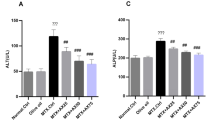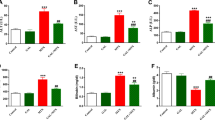Abstract
Methotrexate (MTX), a folic acid antagonist, an effective chemotherapeutic agent is used in the treatment of a wide range of tumors and autoimmune diseases. Moreover, hepatotoxicity limits its clinical use. Several studies have already confirmed that the oxidative stress plays a major role in the pathogenesis of MTX-induced damage in the various organs especially in liver. The aim of this study was to determine the protective effect of Chrysin against MTX-induced hepatic oxidative stress and apoptosis in rats. In the present study, efficacy of Chrysin was investigated against hepatotoxicity caused by MTX in terms of biochemical investigations of antioxidant enzymes, apoptosis, and histopathological alteration in rat liver. In the MTX-treated group there was a significant increase in alanine transaminase, aspartate aminotransferase, lactate dehydrogenase activity and malondialdehyde content as well as decreased glutathione peroxidase, glutathione reductase, superoxide dismutase, catalase activities and reduced glutathione content were also observed compared to the control group as a marker of oxidative stress. Histopathological alterations and apoptosis through the immunopositive staining of p53, cleaved caspases-3 and Bcl-2-associated X protein in rat liver were observed. Pretreatment of Chrysin at both doses prevents the hepatotoxicity by ameliorating oxidative stress, histopathological alterations, and apoptosis and thus our results suggest that Chrysin has a protective effect against hepatotoxicity induced by MTX and it may, therefore, improve the therapeutic index of MTX if co-administration is done.





Similar content being viewed by others
References
Khan ZA, Tripathi R, Mishra B (2012) Methotrexate: a detailed review on drug delivery and clinical aspects. Expert Opin Drug Deliv 9:151–169
Jahovic N, Cevik H, Sehirli AO et al (2003) Melatonin prevents methotrexate-induced hepatorenal oxidative injury in rats. J Pineal Res 34:282–2877
Sener G, Ekşioğlu-Demiralp E, Cetiner M et al (2006) L-Carnitine ameliorates methotrexate-induced oxidative organ injury and inhibits leukocyte death. Cell Biol Toxicol 22:47–60
Uraz S, Tahan V, Aygun C et al (2008) Role of ursodeoxycholic acid in prevention of methotrexate-induced liver toxicity. Dig Dis Sci 53:1071–1077
Kremer JM (2004) Toward a better understanding of methotrexate. Arthr Rheum 50:1370–1382
Mazur AJ, Nowak D, Mannherz HG et al (2009) Methotrexate induces apoptosis in CaSki and NRK cells and influences the organization of their actin cytoskeleton. Eur J Pharmacol 613:24–33
Czaplińska M, Czepas J, Gwoździński K (2012) Structure, antioxidative and anticancer properties of flavonoids. Postepy Biochem 58:235–244
Hemeida RA, Mohafez OM (2008) Curcumin attenuates methotraxate-induced hepatic oxidative damage in rats. J Egypt Natl Cancer Inst 20:141–148
Vardi N, Parlakpinar H, Ates B (2012) Beneficial effects of chlorogenic acid on methotrexate-induced cerebellar Purkinje cell damage in rats. J Chem Neuroanat 4:43–47
Ueki M, Ueno M, Morishita J et al (2013) Curcumin ameliorates cisplatin-induced nephrotoxicity by inhibiting renal inflammation in mice. J Biosci Bioeng 115:547–551
Kumari KK, Setty OH (2012) Protective effect of Phyllanthus fraternus against mitochondrial dysfunction induced by co-administration of cisplatin and cyclophosphamide. J Bioenerg Biomembr 44:179–188
Yuan J, Li W, Tian Y et al (2013) Anti-proliferative effect of Flos Albiziae flavonoids on the human gastric cancer SGC-7901 cell line. Exp Ther Med 5:51–56
Fu Z, Zhen W, Yuskavage J et al (2011) Epigallocatechin gallate delays the onset of type 1 diabetes in spontaneous non-obese diabetic mice. Br J Nutr 105:1218–1225
García-Lafuente A, Guillamón E, Villares A et al (2009) Flavonoids as anti-inflammatory agents: implications in cancer and cardiovascular disease. Inflamm Res 58:537–552
He XL, Wang YH, Bi MG et al (2012) Chrysin improves cognitive deficits and brain damage induced by chronic cerebral hypoperfusion in rats. Eur J Pharmacol 680:41–48
Tahir M, Sultana S (2012) Chrysin modulates ethanol metabolism in Wistar rats: a promising role against organ toxicities. Alcohol Alcohol 46:383–392
Sultana S, Verma K, Khan R (2012) Nephroprotective efficacy of chrysin against cisplatin-induced toxicity via attenuation of oxidative stress. J Pharm Pharmacol 64:872–881
Khan R, Khan AQ, Qamar W et al (2012) Chrysin protects against cisplatin-induced colon. toxicity via amelioration of oxidative stress and apoptosis: probable role of p38MAPK and p53. Toxicol Appl Pharmacol 258:315–329
Anand KV, Mohamed Jaabir MS, Thomas PA et al (2012) Protective role of chrysin against oxidative stress in d-galactose-induced aging in an experimental rat model. Geriatr Gerontol Int 12:741–750
Chen SS, Corteling R, Stevanato L et al (2012) Polyphenols inhibit indoleamine 3, 5-dioxygenase-1 enzymatic activity—a role of immunomodulation in chemoprevention. Discov Med 14:327–333
Pushpavalli G, Veeramani C, Pugalendi KV (2010) Influence of chrysin on hepatic marker enzymes and lipid profile against D-galactosamine-induced hepatotoxicity rats. Food Chem Toxicol 48:1654–1659
Pushpavalli G, Kalaiarasi P, Veeramani C et al (2010) Effect of chrysin on hepatoprotective and antioxidant status in D-galactosamine-induced hepatitis in rats. Eur J Pharmacol 631:36–41
Sathiavelu J, Senapathy GJ, Devaraj R et al (2009) Hepatoprotective effect of chrysin on prooxidant-antioxidant status during ethanol-induced toxicity in female albino rats. J Pharm Pharmacol 61:809–817
Vardi N, Parlakpinar H, Cetin A et al (2010) Protective effect of beta-carotene on methotrexate-induced oxidative liver damage. Toxicol Pathol 38:592–597
Claiborne A (1985) Catalase activity. In: Greenwald RA (ed) CRC handbook of methods for oxygen radical research. CRC Press, Boca Raton,FL, pp 283–284
Marklund S, Marklund G (1974) Involvement of the superoxide anion radical in the autoxidation of pyrogallol and a convenient assay for superoxide dismutase. Eur J Biochem 47:469–474
Jollow DJ, Mitchell JR, Zampaglione N et al (1974) Bromobenzene-induced liver necrosis. Protective role of glutathione and evidence for 3,4-bromobenzene oxide as the hepatotoxic metabolite. Pharmacology 11:151–169
Mohandas J, Marshall JJ, Duggin GG et al (1984) Differential distribution of glutathione and glutathione-related enzymes in rabbit kidney: possible implications in analgesic nephropathy. Biochem Pharmacol 33:1801–1807
Carlberg I, Mannervik B (1975) Glutathione reductase levels in rat brain. J Biol Chem 250:5475–5479
Wright JR, Colby HD, Miles PR (1981) Cytosolic factors which affect microsomal lipid peroxidation in lung and liver. Arch Biochem Biophys 206:296–304
Reitman S, Frankel SA (1957) Colorimetric method for determination of serum glutamic oxaloacetic and glutamic pyruvic transaminases. Am J Clin Pathol 28:56–63
Kornberg A (1955) Methods in enzymology. Academic Press, New York, pp 441–443
Lowry OH, Rosebrough NJ, Farr A et al (1951) Protein measurement with the Folin phenol reagent. J Biol Chem 193:265–275
Khan R, Khan AQ, Qamar W et al (2012) Chrysin abrogates cisplatin-induced oxidative stress, p53 expression, goblet cell disintegration and apoptotic responses in the jejunum of Wistar rats. Br J Nutr 108:1574–1585
Zhao X, Shu G, Chen L et al (2012) A flavonoid component from Docynia delavayi (Franch.) Schneid represses transplanted H22 hepatoma growth and exhibits low toxic effect on tumor-bearing mice. Food Chem Toxicol 50:3166–3173
Ng LC, Lee YY, Lee CK et al (2013) A retrospective review of methotrexate-induced hepatotoxicity among patients with psoriasis in a tertiary dermatology center in Malaysia. Int J Dermatol 52:102–105
Abraham P, Kolli VK, Rabi S (2010) Melatonin attenuates methotrexate-induced oxidative stress and renal damage in rats. Cell Biochem Funct 28:426–433
Vardi N, Parlakpinar H, Ozturk F et al (2008) Potent protective effect of apricot and beta-carotene on methotrexate-induced intestinal oxidative damage in rats. Food Chem Toxicol 46:3015–3022
Kamen BA, Nylen PA, Camitta BM et al (1981) Methotrexate accumulation and folate depletion in cell as a possible mechanism of chronic toxicity to the drug. Br J Hematol 49:355–360
Prey S, Paul C (2008) Effect of folic or folinic acid supplementation on methotrexate associated safety and efficacy in inflammatory disease: a systematic review. Br J Dermatol 160:622–628
Tunali-Akbay T, Sehirli O, Ercan F et al (2010) Resveratrol protects against methotrexate-induced hepatic injury in rats. J Pharm Pharm Sci 13:303–310
Cetin A, Kaynar L, Kocyigit I et al (2008) Role of grape seed extract on methotrexate induced oxidative stress in rat liver. Am J Chin Med 36:861–872
Miyazono Y, Gao F, Horie T (2004) Oxidative stress contributes to methotrexate-induced small intestinal toxicity in rats. Scand J Gastroenterol 39:1119–1127
Mukherjee S, Banerjee SK, Maulik M et al (2003) Protection against adriamycin-induced cardiotoxicity by garlic: role of endogenous antioxidants and inhibition of TNF-α expression. BMC Pharmacol 3:1–9
Yousef MI, Saad AA, El-Shennawy LK (2009) Protective effect of grape seed proanthocyanidin extract against oxidative stress induced by cisplatin in rats. Food Chem Toxicol 47:1176–1183
Sukhotnik I, Nativ O, Roitburt A et al (2013) Methotrexate induces germ cell apoptosis and impairs spermatogenesis in a rat. Pediatr Surg Int 29:179–184
Vardi N, Parlakpinar H, Ates B et al (2012) The protective effects of Prunus armeniaca L (apricot) against methotrexate-induced oxidative damage and apoptosis in rat kidney. J Physiol Biochem. doi:10.1007/s13105-012-0219-2
Maritim AC, Sanders RA, Watkins JB (2003) Effects of alpha-lipoic acid on biomarkers of oxidative stress in streptozotocin-induced diabetic rats. J Nutr Biochem 14:288–294
Prasad V, Chandele A, Jagtap JC et al (2006) ROS-triggered caspase 2 activation and feedback amplification loop in beta-carotene-induced apoptosis. Free Radic Biol Med 41:431–442
Riley T, Sontag E, Chen P et al (2008) Transcriptional control of human p53-regulated genes. Nat Rev Mol Cell Biol 9:402–412
Acknowledgments
The author (Sarwat Sultana) is thankful to University Grants Commission (New Delhi, India), under Special Assistance Programme for Departmental Research Support-II (SAP DRS-II) and Basic Scientific Research (BSR) for providing funds to carry out this work.
Conflict of interest
The authors declare that there are no conflicts of interest.
Author information
Authors and Affiliations
Corresponding author
Rights and permissions
About this article
Cite this article
Ali, N., Rashid, S., Nafees, S. et al. Beneficial effects of Chrysin against Methotrexate-induced hepatotoxicity via attenuation of oxidative stress and apoptosis. Mol Cell Biochem 385, 215–223 (2014). https://doi.org/10.1007/s11010-013-1830-4
Received:
Accepted:
Published:
Issue Date:
DOI: https://doi.org/10.1007/s11010-013-1830-4




